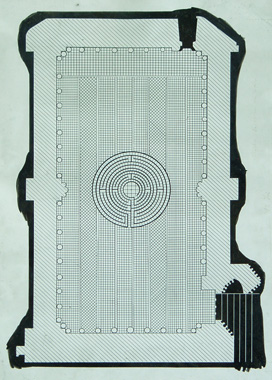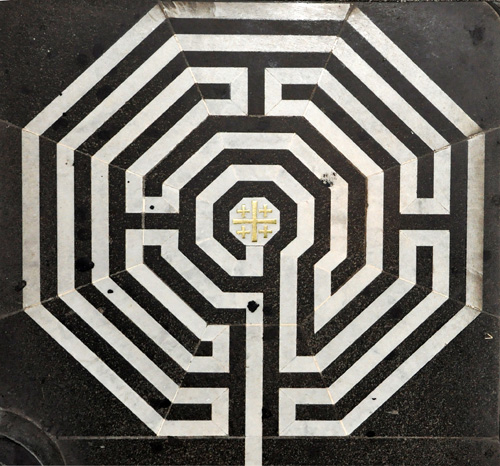
page 2
| The labyrinth and |

page 2 |
the medieval church. |
| Apart from the occurrance of the labyrinth in mythology, they had in real life various purposes like the healing power of a labyrinth in ancient cultures. In another culture walking a labyrinth was connected with the death and the renaissance, that is, one had to pass the tomb in a fatal manner so one could meet the Gods and know the ultimate mysteries of life. Other cultures followed more or less the same principle though be it more friendly, that is, you walk the ways of a labyrinth, which is a symbol of our mortal life, while repenting thus clearing the mind and getting to know the meaning of life. It is this spiritual effect we see in the use of the labyrinth in the church as explained with the labyrinth of Chartres on the previous page. The labyrinth in Amiens has been badly destroyed in 1825 but was reconstructed in 1894. Other labyrinths in France are (or were) in Sens, Arras, St Omer, Auxerre, Reims and Bayeux. |

|
The labyrinth of the cathedral of Bayeux is, contrary to other cathedrals, not found in the nave of the cathedral but in the Chapter House. |
The labyrinth of Reims no longer exists. It was constructed before 1286 and in 1778 its destruction was announced. This labyrinth is of a complex shape. Like the labyrinth in Amiens, the architects are honoured by their efigies in the corners and in the center was the efigy of an archbishop believed to be Aubry de Humbert who started the building of the cathedral. The four architects were Jean d'Orbais (1211-1231), Jean le Loup (1231-1247), Gaucher de Reims (1247-1255) and Bernard de Soissons (1255-1290). Jean d'Orbais was responsible for the geometric structure of the cathedral especially the east end. Jean le Loup dealt among other things with the triforium. Gaucher de Reims finished the east end, the transcept and Bernard de Soissons constructed the west fašade and the great Rose window.
|
| The animation of the labyrinth shows something strange. The architects were very precise
and had an outspoken knowledge of mathematics. Their effigies in the labyrinth however, are placed in a strange order. At first glance in a logical order
namely starting from top right counter clockwise. But if you walk the labyrinth you would expect the effigy of the first architect in
the first corner you arrive and strangly enough, there is the effigy of the last architect to be found. A medieval oversight ? See also www.padrepardo.org under Reims, a site with sound ! |
 Labyrinth in the Cathedral in Cologne, Germany |
| Back to index page | Back to Labyrinth - page 1 | Continue to Labyrinth - page 3 |